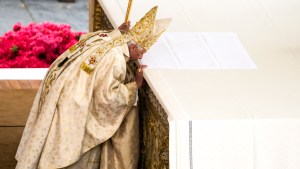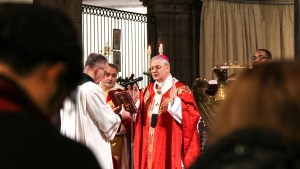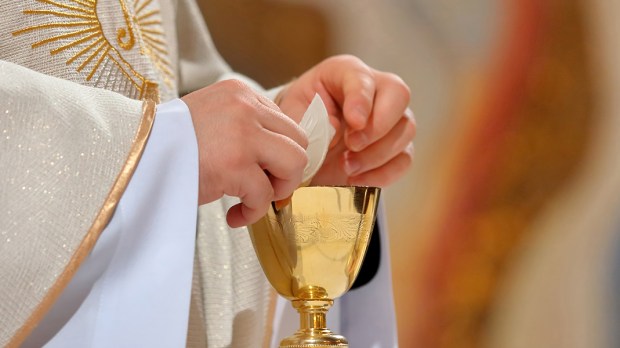During Mass in the Roman Rite of the Catholic Church you may have noticed that the priest will break a small part of the consecrated host and drop it into the chalice of consecrated wine. It is a silent ritual, one that is easily missed as it happens so quickly.
While it is a very brief action, the symbolism behind it is profound.
According to Nikolaus Gihr in the book The Holy Sacrifice of the Mass, the action of placing a small particle of the host into the chalice has roots in the Early Church and a custom that was meant to signify unity with the pope and local bishop.
Participation in the same Holy Sacrifice was regarded as a sign and pledge of ecclesiastical Communion; mutually to prove and maintain this, Popes and bishops sent to other bishops, or priests too, parts of Consecrated Hosts, which the recipients dropped into the chalice and consumed …This custom existed in Rome until about the ninth century. There the Pope on Sundays and feast-days sent to those priests who had charge of Divine service at the churches within the city, the Eucharist as a symbol of communion with the ecclesiastical Head, and as a sign that they were empowered to celebrate.
It was a visible and concrete reminder that they were united to the pope and bishops each time they celebrated the Mass.
Furthermore, another aspect of this ritual was to signify the unity of the celebration of Mass, which is a re-presentation of the one sacrifice of Jesus on the cross. Catholics believe that Jesus is not sacrificed again and again at each Mass, but that the Eucharist is a mystical participation in the one sacrifice that occurred on Mount Calvary.
Formerly the usage was somewhat different. As the Hosts were much larger, one of these three parts was subdivided into several particles and used differently, that is, distributed to those present, or sent to the absent, or put into the chalice at the next sacrificial celebration…A particle previously consecrated was preserved and united to the Precious Blood at the following Sacrifice, to represent, in all probability, the continual succession of the Sacrifice, as well as the unity of the last with the present celebration.
For this reason it is believed by historians that for a few centuries there were two particles in the chalice, one from the pope/bishop and another from a previous celebration.
The symbolism of this act also points to the unity of the body and blood of Jesus in the host, as both the host and consecrated wine contain the whole presence of Jesus, body, blood, soul and divinity.
It is a reminder that each action of the priest at Mass is rooted in nearly 2,000 years of history and tradition and is very deliberate, meant to teach us many profound spiritual truths.

Read more:
This is why the priest kisses the altar at Mass

Read more:
When do we bow our heads at Mass?

